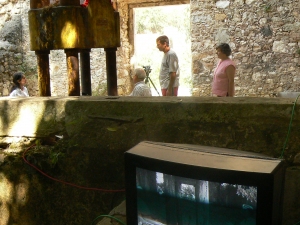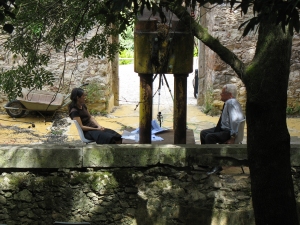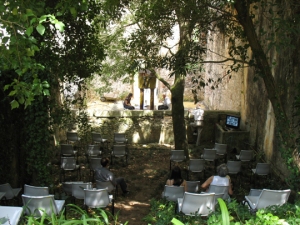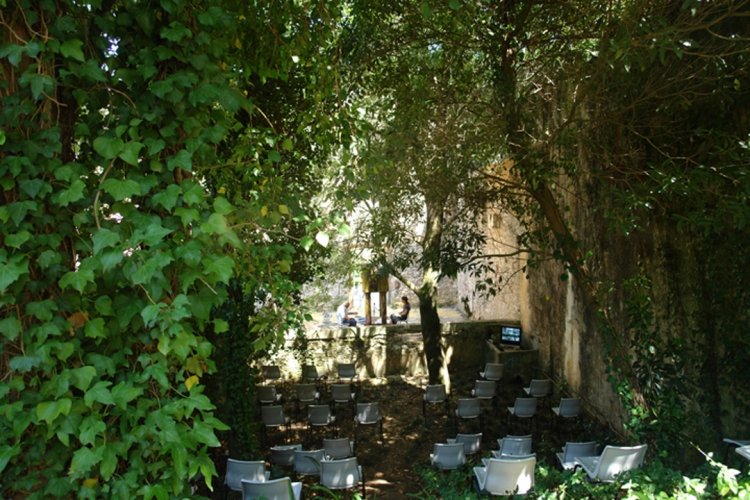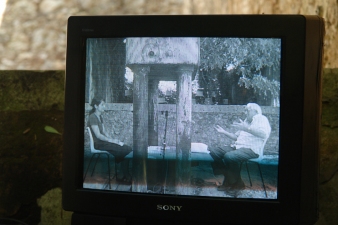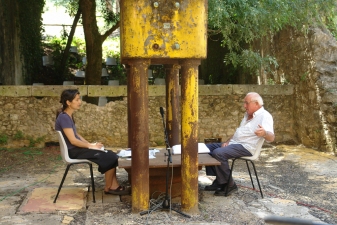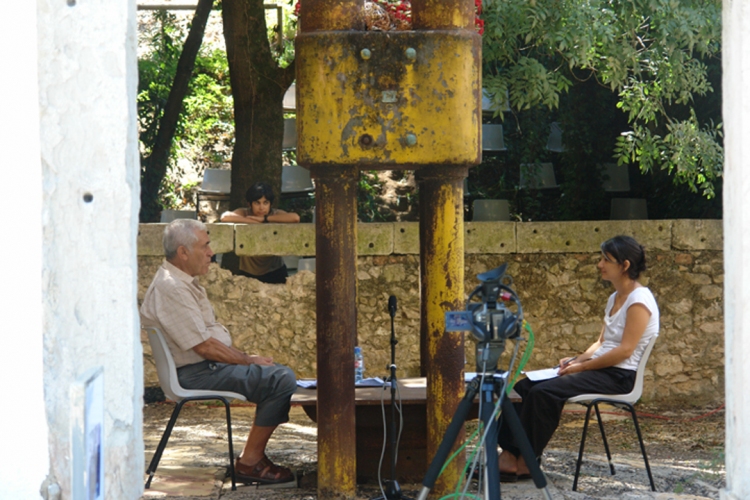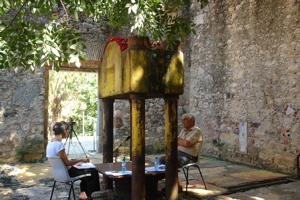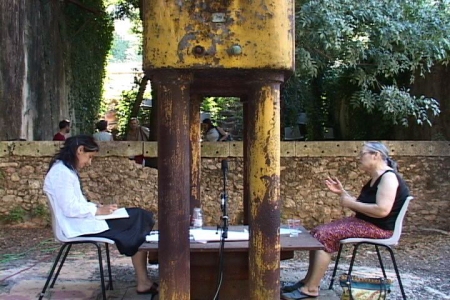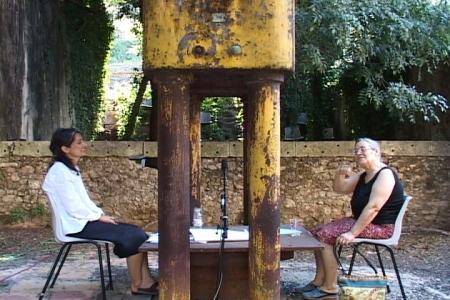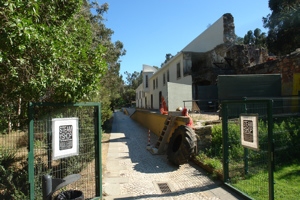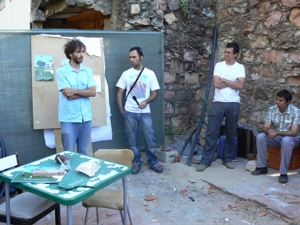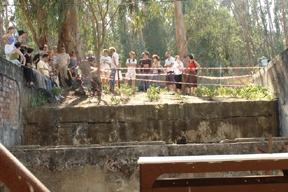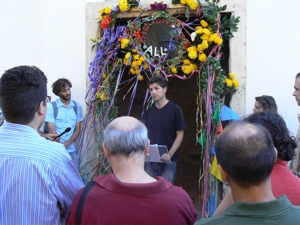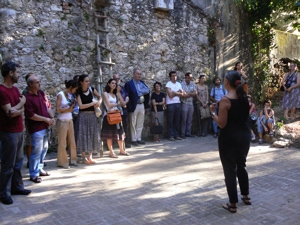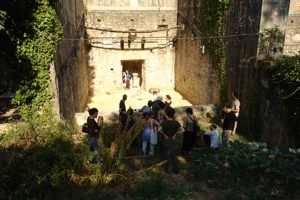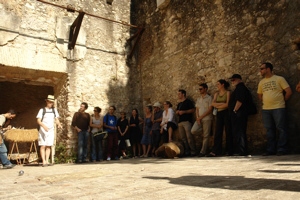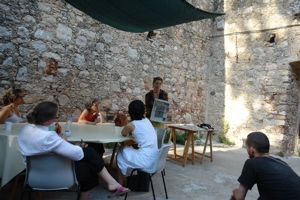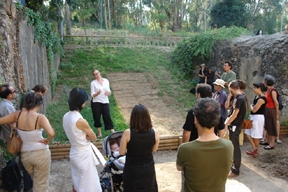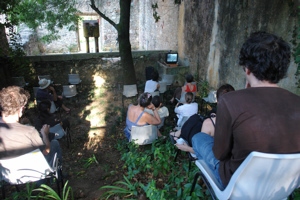2006 The Steam Shop (or the painter's studio)
Text by Bruno Marques
Alexandra do Carmo
interview with Francisco dos Reis (Administrative services, commercial services, military inspection, technical section.)
Alexandra do Carmo
interview with Francisco dos Reis (Administrative services, commercial services, military inspection, technical section.)
When I came, though it belonged to the state, it was rented to the Dutch… The grenades were going to Germany, there was a military inspection from the Portuguese government … I was working in the Army’s inspection office, at the time they were also doing munitions to fight overseas. Later came the 25 of April—the war was ending…The factory even stopped operating by the time of the ‘72 explosion. They continued with those materials but ended the munitions production? The munitions production was in a section up there… It doesn’t exist today, we go up there and can’t see anything, it was the so-called sixth section. When did you realize that there was a production for war purposes? Right way when I started here in the factory. Was here a separated section? Only black gunpowder.
ateliê #10
Alexandra do Carmo
entrevista com Francisco dos Reis (Serviços Administrativos Seviços Comerciais Inspecção Militar, Secção Técnica)
Alexandra do Carmo
entrevista com Francisco dos Reis (Serviços Administrativos Seviços Comerciais Inspecção Militar, Secção Técnica)
Entrei em Setembro de 1956, faz este ano 50 anos. Quando vim para cá estava arrendado aos Belgas, apesar de ser do estado….as granadas iam para a Alemanha, havia uma inspecção do exercitio Português que fiscalizava...A Fundição de Oeiras tomou conta disto...recaiu em mim, vais trabalhar com o exercito mas já sabes tens que te portar na linha…estive a trabalhar no gabinete da inspecção da Força Aérea na altura também faziam munições para combater no ultramar. Depois deu-se o 25 de Abril, a guerra foi acabando e passei para a chamada secção técnica onde tinha uma chefe, a Teresa Adrão. A fabrica deixou mesmo de funcionar quando se deu esta explosao aqui em 72. --Faziam só os petardos para os caminhos de ferro. Continuaram com esses materiais mas acabaram com o fabrico de munições?
O fabrico de munições era numa secção lá em cima… já não existe hoje, a gente chega lá e não vê nada, era a chamada sexta secção. -- Quando é que percebeu que havia fabrico de munições para Guerra? Logo que entrei para a fábrica…Aqui era uma secção à parte?
Só pólvora negra.
O fabrico de munições era numa secção lá em cima… já não existe hoje, a gente chega lá e não vê nada, era a chamada sexta secção. -- Quando é que percebeu que havia fabrico de munições para Guerra? Logo que entrei para a fábrica…Aqui era uma secção à parte?
Só pólvora negra.
interview with Joaquim Pereira (Worked in the Steam Shop building itself (originally called the painted fountain)
I worked in all the shops, one week at the pressing machine, another at the granulator another at the grinder, it was like this… Do you know how many shops there were from here to there? Ten, ten shops! Here there were two kinds of compressing machines, with copper plates. Was this object a pressing machine? Yes, it was a pressing machine! It would compress until the desired density. On that side there was nothing… How was the big accident here inside the steam shop? The last started inside one of the shops, one that had two blending machines, one of them needed to be fixed, it had to be brought outside… They asked some workers to go get it, three on each side… The one that was on the outside corner slipped and caused a spark... The fire communicated with the other shops. Did the workers discuss the war among themselves? No, nor that was of any interest, the engineers, foreman and so on did not want these kind of discussions... I entered here millions of times…
entrevista com Joaquim Pereira (Oficinas a Vapor (anteriormente conhecidas como a fonte caiada)
Percorri as oficinas todas, uma semana na prensa, outra no granizador, outra no triturador..era assim,.. para a outra semana vou para a misturação dos componentes…Sabe quantas oficinas tinha daqui até lá cima?, 10, dez oficinas! ..Aqui havia duas especies de prensa, havia umas chapas de cobre.--Isto era uma prensa? Era, era uma prensa!.. primia até a densidade que a gente queria. Daquele lado não havia nada… admiro é como é que eles autorizaram pôr ali aquelas cadeiras… está lá uma rapariga…mas isto por acaso está engraçado..ah, mas estão ali umas poucas de cabeças.. --Como foi o acidente aqui nas oficinas? A ultima foi numa oficina que tinha duas misturadoras digamos assim, uma estava avariada e tinha que sair lá para fora.. pediram a serventes para a ir buscar, 3 de cada lado,…o que ia da parte de fora escapou-lhe a mão, fez faisca.. comunicou dentro da oficina.--Os trabalhadores falavam da Guerra das colonias? Não, nem interessava para nada, os engenheiros, contra mestres e assim, não queriam conversas dessas.
..eu entrei aqui milhares de vezes..
..eu entrei aqui milhares de vezes..
interview with Mário Ramos (Woodshop, Charcoal production and others)
When it happened, I was the one taking them to the outside [the bodies], me and another guy that already passed away—he was a fireman in Barcarena. There were nine explosions-- boom, boom! One per space? Yes. The working conditions were very bad… My uncle Sidónio, worked with metal chains that once in a while used to break from overloading, they provoke sparks and that was it… There was politics here… They came to take a guy out of here… We had a small communist newspaper…one day... two clients [political police] showed up here... the engineer called him, ‘Hey Serafim! Come over here to my office, there are two people who want to speak with you!’ I switched to his working post, stayed in his place… and by chance, I opened the drawers. Do you want to know what happened? I took all the communist newspaper propaganda and burned it! They took him right way to Caxias fortress [infamous prison for political prisoners]. Serafim? He was fired and was in jail for eight months I suppose…
entrevista com Mário Ramos (Serralharia, Carbonização e outros)
Quando foi aqui, eu é que os tirei, eu e mais um que já morreu, era bombeiro em Barcarena.. Foram nove explosões; bum, bum.. uma por espaço? sim
Um bocado de viga dessas estava a arder com duas toneladas de pólvora ai por baixo..
As condições eram muito más..O meu tio Sidónio, tinha umas correias que algumas vezes arrebentavam de tanto trabalhar, fazia faísca… e pronto… o meu tio… tinha queimaduras fundas.. lá se safou, era rijo.. estava era aborrecido pois, porque não lhederam mais dinheiro… dois contos por ano! Houve aí politicas…Vieram cá buscar um rapaz…
Tinhamos um jornal pequenino do Partido Comunista.. um dia apareceram cá dois fregueses.. o engenheiro chamou-o, oh Serafim chegue aqui ao meu gabinete, estão aqui duas pessoas para falar consigo.. eu fiquei no lugar dele… e calhei de ir ver as gavetas.. e sabe o que aconteceu? Agarrei na propaganda do Partido e deitei fogo aquilo tudo.. .
Levaram-no logo para o forte de Caxias… então e o Serafim?..foi despedido e esteve preso 8 meses acho..
Um bocado de viga dessas estava a arder com duas toneladas de pólvora ai por baixo..
As condições eram muito más..O meu tio Sidónio, tinha umas correias que algumas vezes arrebentavam de tanto trabalhar, fazia faísca… e pronto… o meu tio… tinha queimaduras fundas.. lá se safou, era rijo.. estava era aborrecido pois, porque não lhederam mais dinheiro… dois contos por ano! Houve aí politicas…Vieram cá buscar um rapaz…
Tinhamos um jornal pequenino do Partido Comunista.. um dia apareceram cá dois fregueses.. o engenheiro chamou-o, oh Serafim chegue aqui ao meu gabinete, estão aqui duas pessoas para falar consigo.. eu fiquei no lugar dele… e calhei de ir ver as gavetas.. e sabe o que aconteceu? Agarrei na propaganda do Partido e deitei fogo aquilo tudo.. .
Levaram-no logo para o forte de Caxias… então e o Serafim?..foi despedido e esteve preso 8 meses acho..
interview with Carlos Dias (Woodshop, Electrical room, loading grenades)
How old were you when you started working in the Factory? Fifteen years old. The grenade section was made in the sixties… It was made in order to satisfy a requested by the Americans… and later the Germans, the Iraqis, I still remember the last shipment; it was to “Iraq-Quindama” around 1975. Here was section number two, known as the “Painted fountain” Was this shop very important? Yes it was, this one and all the others in this building. The first explosion during the time I was here happened in 1947 … The last one was, if I am not mistaken inside the second or third shop starting from the other extreme of the building. We thought that this was the way to make our lives right? We were building things, and I would look to a grenade, and think to myself: ‘after, when this is used, how many people am I going to kill? Yes, later one becomes more conscious about things… The women earned the same amount of money as men? No, not at the time, when women were admitted at the factory there was feminine worker and masculine workers—they discriminated… After the 25th of April the law was better in terms of working conditions, payment, the rights of the workers, …in time it became better. The Factory the way it is now? I think it is good this way.
entrevista com Carlos Dias (Serralharia, Central Electrica, Carregamento de Granadas)
Quantos anos tinha quando entrou para a Fábrica? 15 anos. Nos anos sessenta é que a seccão de granadas foi feita…a secção foi feita por causa de uma grande encomenda para a América..mais tarde para a Alemanha, Iraque, Irão, a ultima ainda me lembro, foi Iraque - Quindama, por volta de 75. Aqui era a segunda secção, conhecida pela fonte caiada.-- Esta oficina era bastante importante? Era, esta e as outras todas por aí fora. A primeira explosão enquanto eu cá estive foi em 1947.. A ultima explosão aqui, foi salvo o erro na segunda ou terceira oficina a contar lá do fundo. Pensava-se, era a maneira da gente ganhar a vida não e?…a gente estava a fabricar as coisas e olhava assim para uma granada.., depois disto tudo desfeito quantas pessoas não vou matar… sim, mais tarde a gente começa a ter mais consciência das coisas… --As mulheres ganhavam o mesmo que os homens? Não, naquela altura não, quando eram admitidos eram servente feminino, servente masculino.. eles descriminavam.. depois do 25 de Abril entrou um ordenado unico. Depois do 25 de abril cumpria-se melhor a lei no que respeita a condições de trabalho, ordenados…acabou por melhorar. A fábrica assim como está? , acho que está bem.
interview with Emilia Silva(Sixth Section - loading grenades)
I don’t know how it was. What I know is that the grenades were sold to the Germans and later they would show up in Angola… The solders, when they came home, the ones that actually survived… They used to say ‘Hey! Over there we saw something with a cover saying Barcarena gunpowder and munitions … [used against the Portuguese troops]. And of course, keep your mouth shut! No one could speak; we wouldn’t know what might happen… There was the political police at the time… Sure, some fear… Which year are we talking about? Nineteen fifty seven or eight or even before… We women were ashamed of certain things and of speaking about it.
So, at time I was earning ninety escudos per week [less than two euros]. I assisted on at least one [industrial accident], fourth of March, nineteen something… I am not sure, three died, Ilidio, Costa de S.Marcos and a boy from Alentejo, from Crato…Zacarias. The dog barked, barked and so they found a leg on top of the eucalyptus…
So, at time I was earning ninety escudos per week [less than two euros]. I assisted on at least one [industrial accident], fourth of March, nineteen something… I am not sure, three died, Ilidio, Costa de S.Marcos and a boy from Alentejo, from Crato…Zacarias. The dog barked, barked and so they found a leg on top of the eucalyptus…
EMILIA SILVA
(6 Secção- Carregamento de Granadas)
Não sei como era, sei que as granadas eram vendidas
para os alemães e depois iam aparecer em
Angola…os soldados quando vinham, aqueles que
realmente sobreviveram…, diziam epa! A gente viu lá
umas coisas que tinham uns envolocros que diziam
Pólvoras e Munições de
Barcarena. …[utilizadas contra as tropas
Portuguêsas] e bico calado, ai daquele que falásse…
havia a pide naquela altura… pois, um certo
medo, … --Estamos a falar de que ano?….1957/58
ou até antes.. Tinhamos uma certa vergonha de
falar… Então eu na altura ganhava 90 escudos por
semana. Assisti a pelo menos uma, 4 de Março de
196.. e qualquer coisa, morreram 3, o Ilidio, o Costa
de S. Marcos e um rapaz alentejano, do Crato..
Zacarias.. O cão ladrava, ladrava e foram então dar
com uma perna em cima do eucalipto..
(6 Secção- Carregamento de Granadas)
Não sei como era, sei que as granadas eram vendidas
para os alemães e depois iam aparecer em
Angola…os soldados quando vinham, aqueles que
realmente sobreviveram…, diziam epa! A gente viu lá
umas coisas que tinham uns envolocros que diziam
Pólvoras e Munições de
Barcarena. …[utilizadas contra as tropas
Portuguêsas] e bico calado, ai daquele que falásse…
havia a pide naquela altura… pois, um certo
medo, … --Estamos a falar de que ano?….1957/58
ou até antes.. Tinhamos uma certa vergonha de
falar… Então eu na altura ganhava 90 escudos por
semana. Assisti a pelo menos uma, 4 de Março de
196.. e qualquer coisa, morreram 3, o Ilidio, o Costa
de S. Marcos e um rapaz alentejano, do Crato..
Zacarias.. O cão ladrava, ladrava e foram então dar
com uma perna em cima do eucalipto..
This project started with a desire of investigating the profound relations expressed between artist and public in Gustave Courbet’s painting, L’Atelier du peintre, allégorie réelle déterminant une phase de sept années de ma vie artistique (1855), in a concrete space. Reconsidering them through the artistic practices of the participants, the painting would serve as a starting point, and from it the artists would establish a close relationship with the locale. The architecture of the place allowed me to de-center the exploration into ten individual projects, with ten artists/collectives— a continuous open studio in the format of an artist residency. In this way a dialogue could be entered into with one of the most controversial aspects of the painting— Courbet’s central positioning. The physical condition of the building, literally exploded, suggests a special relationship with the theatrical and performative, aspects of both of these are evident aspects in the painting. In the Steam Shop structure there is always a mixture between interior and exterior, revealing a potential encounter with the public and with the social and political aspects within the painting. Could the artists extend their practices to the local community, questioning the locale where their artistic production is being developed? The history of gunpowder production, the colonial war and its effect on daily working life during the Salazar dictatorship are other important aspects that actually encounter a parallel in Courbet’s life, himself a silenced critic of the reactionary regime of Napolean the third. My project within the collective Steam Shop Project was an installation/performance using video and audio where I return five ex-workers to their workplace, a now ruined gunpowder factory, (Fábrica da Pólvora de Barcarena). I interviewed them in a constructed public theatre concerning their work and the social-political conditions in Portugal before the 1974 revolution.


